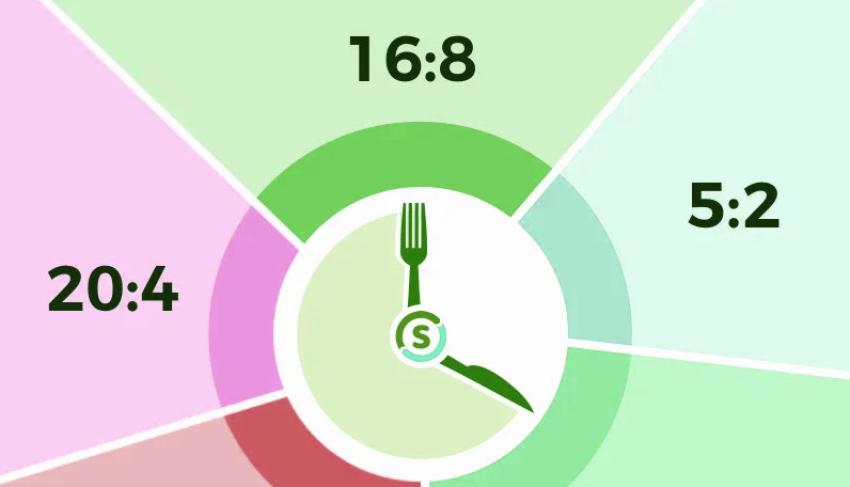
In this article, I’ll try to cover the types of intermittent fasting, most of the benefits it is claimed to provide, and some of the biggest myths about fasting that I’ve personally observed.
Let’s first mention the main types of intermittent fasting:
Daily fasting, where each day you have a limited eating window and fast for the rest of the day. The minimum fasting duration is 14 hours. Popular protocols include 16:8, 18:6, and 20:4, where the first number indicates the fasting hours (no calorie intake) and the second number is the eating window.
Alternate-day fasting, known as the "eat-stop-eat" method – once or twice a week, you fast for 24 hours, consuming only water, while eating normally on the other days.
5/2 method – a milder version of alternate-day fasting. On two non-consecutive days of the week, you limit your calorie intake to 500 kcal per day.
Multi-day fasting – this exceeds 24 hours, typically aiming for 48 or 72 hours (three consecutive days). Such fasts are often tied to the lunar calendar or so-called moon diets, where fasting occurs around lunar phases – for example, from 24 hours before the full moon to 48 hours after, if trying to complete a 72-hour fast.
Some people fast even longer – 5, 6 days or a week and more. However, in such cases, it is essential to consult a doctor, be under medical supervision, and at the very least, take in some vitamins and macronutrients during the extended fast.
Of all the types, the easiest to follow are the 16:8 or 18:6 methods. In practice, the simplest approach is to skip breakfast. For example, if you had dinner at 8 p.m., and don’t eat until noon the next day, you’ve fasted for 16 hours. If you move dinner earlier to 6 p.m., you’re in an 18:6 pattern.
Personally, I often follow these two approaches and aim to finish dinner between 6 and 7 p.m. Lately, I’ve also experimented with 24-hour fasts following the lunar diet – that is, during moon phases like the new moon and/or full moon.
What happens in your body during fasting:
The body’s main energy sources are glucose and fatty acids. When fasting begins, it takes about 12 hours for the body to deplete the glucose in the blood and the glycogen stored in muscles and the liver.
Once glucose is depleted and no food is consumed, insulin production drops, giving the pancreas a rest. This is particularly beneficial for people in prediabetic states or with insulin resistance. Intermittent fasting improves insulin sensitivity and reduces the risk of developing diabetes.
Fats from previous meals are stored in the body’s fat deposits as triglycerides. When glucose and glycogen are used up, the body starts converting triglycerides into fatty acids and glycerol. The liver then converts these fatty acids into ketones, which fuel the body and brain.
Ketone levels begin to rise about 12 hours into a fast and continue to rise over the next 24 hours. During extended fasts, they increase even more. Ketones are not just an energy source; they also regulate metabolism and influence aging and overall health.
Around 14 hours into fasting, the level of human growth hormone (hGH), or somatotropin, increases. This promotes fat burning, ketone production, and helps build muscle mass.
Another major benefit of fasting is autophagy – the process through which the body begins to "self-eat," recycling damaged cells, viral debris, and other waste into energy. Autophagy typically begins about 20 hours after your last meal. That’s why, in addition to 16:8 protocols, it’s beneficial to occasionally do 24-hour or slightly longer fasts.
Autophagy replaces old cells with new ones, which has strong anti-aging effects. In animal studies, mice subjected to intermittent fasting lived 15–20% longer than the control group.
In summary, here are the benefits of intermittent fasting:
- Increases insulin sensitivity
- Normalizes ghrelin, the hunger hormone
- Improves leptin sensitivity
- Reduces triglyceride levels
- Improves cardiovascular health
- Boosts growth hormone production
- Greatly reduces inflammation
- Strengthens the immune system
- Stimulates cellular regeneration
- Slows down or halts cancer cell growth
- Reduces risk of neurodegenerative diseases like Alzheimer’s, Parkinson’s, etc.
- And many more benefits.
Now, let’s address the biggest myth about intermittent fasting:
That you will lose weight just by fasting.
From personal experience, I can tell you: you won’t lose weight from intermittent fasting alone. To lose weight, you need to create a caloric deficit over a week, a month, etc. Weight loss is a long-term process.
For example, if your daily maintenance need is 2,000 kcal, that adds up to 14,000 kcal per week. If you fast two days a week but eat 3,000 kcal on the remaining five days, that’s a total of 15,000 kcal – 1,000 kcal above your weekly needs. In that case, weight loss won’t happen!
That said, intermittent fasting provides many beneficial effects for your body. And when combined with a modest calorie deficit, consistency will bring results.
Add new comment